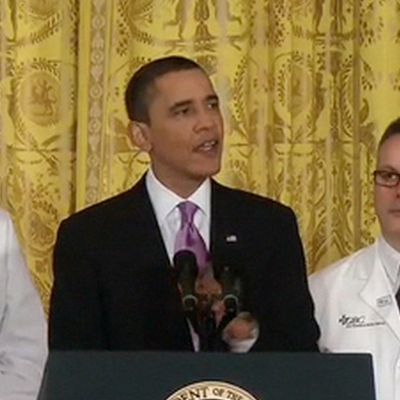
With healthcare.gov lurching toward functionality, the next wave in Obamacare disaster coverage revolves around President Obama’s oft-repeated promise, “If you like your doctor, you can keep your doctor.” Let me spoil the suspense: Not everybody is going to keep their doctor. Last week, CNN’s Jonathan Karl grilled White House press secretary Jay Carney in a testy exchange (Karl: “Is this another promise where he needs to kind of modify because that’s not what he said?”). Time’s Alex Altman calls this “Obamacare’s Next Broken Promise.”
Is it? While the Keep Your Plan promise is relatively clear, the Keep Your Doctor controversy is flecked with shades of gray. On the one hand, those people who have to change their health-care plan also have to change their provider network, so cases can certainly be found of people no longer able to afford access to their previous doctor.
On the other hand, like losing your health-care plan, this is the kind of churn that the health-care market itself has produced for many years. The government couldn’t literally promise that people could keep their doctor no matter what — what if your doctor jacks up prices? Or retires? Rather, Keep Your Doctor was mainly offered as a rebuttal to the ever-present accusation that Obamacare amounted to a form of socialized medicine that would dictate by fiat which doctors a patient could see. If you want to keep your doctor, you can, as long as you or your insurer agree to pay compensation for services rendered at a level your doctor deems worthwhile. That was true before Obamacare, and remains true now.
The main difference between Keep Your Plan and Keep Your Doctor is that Obamacare’s disruption of the individual insurance market was a conscious policy choice. Obamacare creates regulations that, by design, phase out health-care plans that are based on skimming healthy people off the insurance pool. It does not create regulations designed to force people out of existing doctor-patient relationships. Keep Your Plan has been a political disaster for Obama because it was a broken promise. Keep Your Doctor is not even close to a clear-cut broken promise.

There’s another way in which the Keep Your Doctor issue differs from Keep Your Plan: It highlights a way in which Obamacare is fulfilling a professed goal of conservative health-care policy. The new health-care law creates exchanges where private insurers compete for customers. The good news about these exchanges is that they are succeeding at their goal of holding down prices. Premiums on the exchanges turn out to be around 20 percent lower than the authors of the law ever expected.
Why? Because the law is working the way its (Republican) designers wanted. It’s making customers more sensitive to price. Of course, the flip side of this dynamic is that the ruthless price competition is encouraging insurers to squeeze doctors and hospitals. The most affordable plans on the exchanges often exclude more expensive providers.
The news media has mostly reported this as a story about suffering and loss. The Wall Street Journal reports on the concerns of doctors facing lower reimbursements. A Washington Post story about customers in the new exchanges finding limits on their providers, which is framed largely as a tale of deprivation on the new exchanges, shows us an unhappy couple that has discovered their most affordable plan does not include treatment at Seattle Children’s Hospital, where they have received regular treatment for their sick child. Why not? Because, it reports, “a pediatric appendectomy at Children’s costs about $23,000, he said. At another community hospital, the cost is closer to $14,100.”
Well, there’s your problem right there. And this is a problem that’s emblematic of the entire American medical system. Americans pay the highest prices in the advanced world for medical procedures. What’s more, the price for comparable procedures varies wildly within the United States, for reasons (as Steven Brill memorably chronicled) that bear little relation to market forces. The exchanges turn out to be imposing some real market discipline on the process. People may like the idea of being able to go to any doctor or hospital, but what they really want is to pay low insurance premiums. The market is giving them what they want. Some people are not keeping their doctors because, it turns out, they don’t want to pay for the privilege.
Keep Your Plan has been a perfect issue for conservatives because the protagonists of the story are people they want to protect: healthy individuals buying unregulated insurance on the individual market. The conservative health-care vision would keep and expand the ability of these people to enjoy the financial benefits of their good health.
Keep Your Doctor, on the other hand, flies directly in the face of conservative orthodoxy. Conservatives don’t want to protect everybody’s right to keep their doctor. They want to build on the same market forces that are creating the Keep Your Doctor sob stories. Hatred for Obamacare is such an idée fixe on the right that it is impossible for conservatives to admit that the hated law is carrying out their idea, but that is exactly what is happening.






























